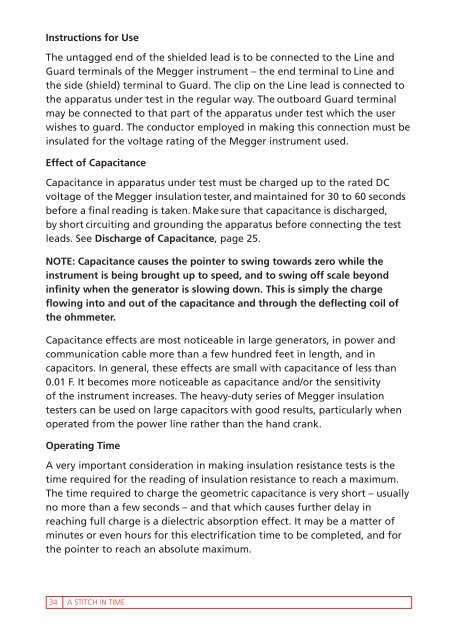“A Stitch in Time...”
Create successful ePaper yourself
Turn your PDF publications into a flip-book with our unique Google optimized e-Paper software.
Instructions for Use<br />
The untagged end of the shielded lead is to be connected to the L<strong>in</strong>e and<br />
Guard term<strong>in</strong>als of the Megger <strong>in</strong>strument – the end term<strong>in</strong>al to L<strong>in</strong>e and<br />
the side (shield) term<strong>in</strong>al to Guard. The clip on the L<strong>in</strong>e lead is connected to<br />
the apparatus under test <strong>in</strong> the regular way. The outboard Guard term<strong>in</strong>al<br />
may be connected to that part of the apparatus under test which the user<br />
wishes to guard. The conductor employed <strong>in</strong> mak<strong>in</strong>g this connection must be<br />
<strong>in</strong>sulated for the voltage rat<strong>in</strong>g of the Megger <strong>in</strong>strument used.<br />
Effect of Capacitance<br />
Capacitance <strong>in</strong> apparatus under test must be charged up to the rated DC<br />
voltage of the Megger <strong>in</strong>sulation tester, and ma<strong>in</strong>ta<strong>in</strong>ed for 30 to 60 seconds<br />
before a f<strong>in</strong>al read<strong>in</strong>g is taken. Make sure that capacitance is discharged,<br />
by short circuit<strong>in</strong>g and ground<strong>in</strong>g the apparatus before connect<strong>in</strong>g the test<br />
leads. See Discharge of Capacitance, page 25.<br />
NOTE: Capacitance causes the po<strong>in</strong>ter to sw<strong>in</strong>g towards zero while the<br />
<strong>in</strong>strument is be<strong>in</strong>g brought up to speed, and to sw<strong>in</strong>g off scale beyond<br />
<strong>in</strong>f<strong>in</strong>ity when the generator is slow<strong>in</strong>g down. This is simply the charge<br />
flow<strong>in</strong>g <strong>in</strong>to and out of the capacitance and through the deflect<strong>in</strong>g coil of<br />
the ohmmeter.<br />
Capacitance effects are most noticeable <strong>in</strong> large generators, <strong>in</strong> power and<br />
communication cable more than a few hundred feet <strong>in</strong> length, and <strong>in</strong><br />
capacitors. In general, these effects are small with capacitance of less than<br />
0.01 F. It becomes more noticeable as capacitance and/or the sensitivity<br />
of the <strong>in</strong>strument <strong>in</strong>creases. The heavy-duty series of Megger <strong>in</strong>sulation<br />
testers can be used on large capacitors with good results, particularly when<br />
operated from the power l<strong>in</strong>e rather than the hand crank.<br />
Operat<strong>in</strong>g <strong>Time</strong><br />
A very important consideration <strong>in</strong> mak<strong>in</strong>g <strong>in</strong>sulation resistance tests is the<br />
time required for the read<strong>in</strong>g of <strong>in</strong>sulation resistance to reach a maximum.<br />
The time required to charge the geometric capacitance is very short – usually<br />
no more than a few seconds – and that which causes further delay <strong>in</strong><br />
reach<strong>in</strong>g full charge is a dielectric absorption effect. It may be a matter of<br />
m<strong>in</strong>utes or even hours for this electrification time to be completed, and for<br />
the po<strong>in</strong>ter to reach an absolute maximum.<br />
34<br />
A STITCH IN TIME



